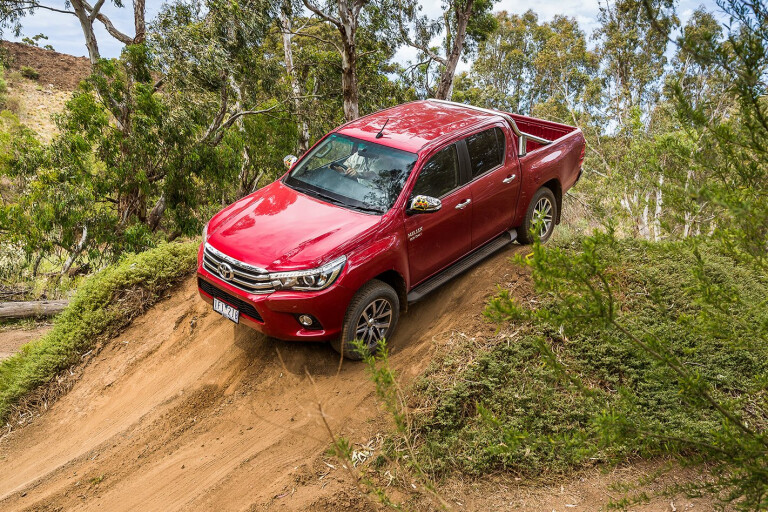
Approaching half a century of Hilux production, Toyota has delivered its eighth-generation Hilux workhorse and – as was the case with each new generation before it – it’s more passenger car-like, more functional and more capable than its predecessor.
As the best-selling 4x4 vehicle in Australia in 2014 (it’s shaping up to take that gong again in 2015), a new Hilux is big news for 4x4 buyers, and the new model was one of the most keenly anticipated launches of the year. Toyota made us wait, as it was the last of the new and updated utes to hit the market in 2015.
The wait was worth it. While the Hilux doesn’t raise the bar in the one-tonne ute segment, it has caught up with the competition, and the new model surpasses the old model both on- and off-road.
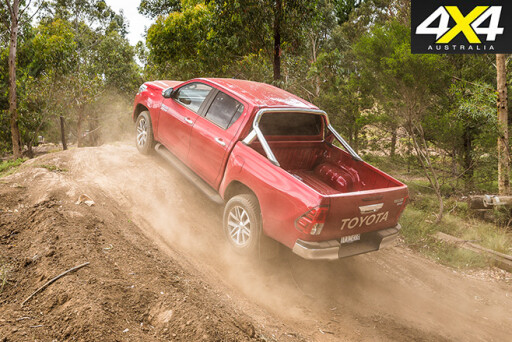 The new Hilux ticks all the boxes; with its new 2.8-litre 1GR diesel engine; new six-speed transmissions; longer-travel suspension for better off-road ability; vastly improved electronic chassis and traction aids; heavier-load and towing capacities to match the class leaders; and a more modern look inside and out.
The new Hilux ticks all the boxes; with its new 2.8-litre 1GR diesel engine; new six-speed transmissions; longer-travel suspension for better off-road ability; vastly improved electronic chassis and traction aids; heavier-load and towing capacities to match the class leaders; and a more modern look inside and out.
The model supplied for 4X4OTY was the double-cab SR5 auto, with the optional leather seats pack.
TOURING
The first thing you notice about the latest Hilux is that it has a more modern and accommodating interior. It is more passenger car-like and better suited to long-haul driving with the family on board, especially in this top-spec model.
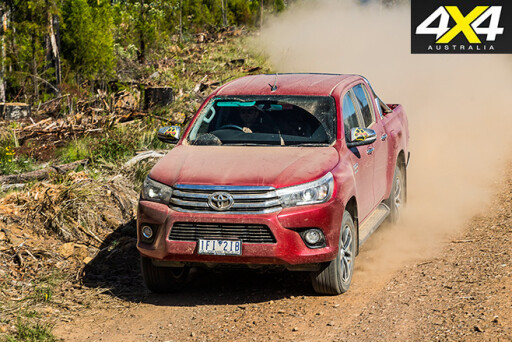 Drive away, however, and you’re instantly reminded that this is a load-hauling truck. The rear suspension is firm and jittery on poor and broken road surfaces – to the point of being downright uncomfortable. This is worse at low speeds, but it gets better as you go faster. From past experience, it isn’t such a problem with a load in the tray.
Drive away, however, and you’re instantly reminded that this is a load-hauling truck. The rear suspension is firm and jittery on poor and broken road surfaces – to the point of being downright uncomfortable. This is worse at low speeds, but it gets better as you go faster. From past experience, it isn’t such a problem with a load in the tray.
The 1GR-FTV engine is adequate but no rocket ship, and the six-speed auto can get busy over undulating highway as it hunts for the most efficient cog. Interestingly, the Hilux consumed 11.8L/100km – the same amount of diesel as the Fortuner on test. Its official ADR figure is 8.5L/100km, and the tank holds 80 litres of fuel.
TRAIL DRIVING
As expected, the Hilux applies itself well to off-road tracks. It has the same powertrain and part-time 4x4 system as the Fortuner. Visibility is good, performance is adequate and the traction control system is excellent.
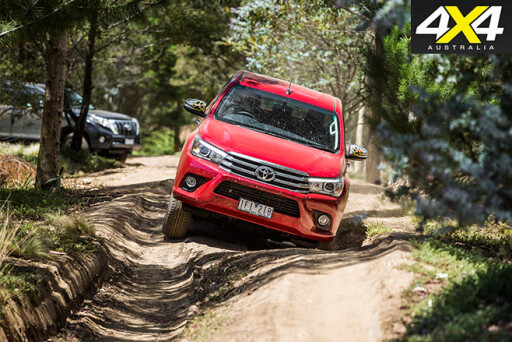 We might have expected the longer wheelbase of the ute to smooth out the ride a bit, but the heavy-duty leaf springs under the back counter that idea.
We might have expected the longer wheelbase of the ute to smooth out the ride a bit, but the heavy-duty leaf springs under the back counter that idea.
SET-PIECE HILL CLIMB
Just like what happened with the Fortuner, the ETC did a far better job of getting the Toyota up our rutted hill than the rear diff lock did. This is because the RDL cancels out the ETC and limits your traction aids to just the rear axle.
It feels like a rear-drive-only car with the diff lock engaged and struggles to climb. The longer wheelbase did do it some favours here, but that had more to do with the spacing of the ruts and holes in the track.
 In low range, first-gear engine braking provides nice downhill control and the auto SR5 also gets downhill-assist control, which seems to do its job well, too.
In low range, first-gear engine braking provides nice downhill control and the auto SR5 also gets downhill-assist control, which seems to do its job well, too.
CABIN, EQUIPMENT AND ACCOMMODATION
The Hilux now has a much more comfortable and passenger car-like interior and that’s a good and a not-so-good thing. While all of our judges appreciate the added comfort and functionality, none of them liked the tablet-style media screen and its fiddly buttons – reflections on the screen’s surface also make it hard to see its display. The way it’s placed on the dash makes it seem like it was an afterthought.
A few of our drivers also criticised the grab handle on the driver’s-side roof. It almost knocked a couple of us out when we banged our heads on it at different times when driving over rough terrain. It isn’t needed there, or at least it could be a folding one that sits flush when it’s not being used.
 There is plenty of power available in the SR5 cab – two 12-volt outlets and a single USB outlet up front, and a 220-volt outlet in the console. The fold-out shopping bag holders on the backs of the front seats are another nice and very useful touch. The seats are small but comfortable, and rear-seat accommodation is good. Our taller drivers felt that the steering wheel reach didn’t come out far enough, but at least the Hilux now has reach adjustment, unlike some utes.
There is plenty of power available in the SR5 cab – two 12-volt outlets and a single USB outlet up front, and a 220-volt outlet in the console. The fold-out shopping bag holders on the backs of the front seats are another nice and very useful touch. The seats are small but comfortable, and rear-seat accommodation is good. Our taller drivers felt that the steering wheel reach didn’t come out far enough, but at least the Hilux now has reach adjustment, unlike some utes.
PRACTICALITIES
The SR5 wears 18-inch alloy wheels and 265/60R-18 tyres but happily accepts the 17s that are fitted to lower-grade models, or aftermarket wheels, offering more tyres choices. Like the Fortuner, the Hilux has very limited space inside the front ’guards, so fitting larger tyres is an issue, but we expect the aftermarket to come up with some fixes for that.
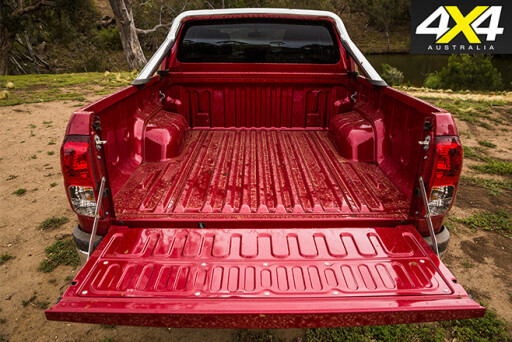 The SR5 has a smooth-sided cargo tub without the external tie-off points that the Workmate and SR models have. That can be good or bad, depending on your use of the vehicle. Inside the tub there is a hitch point at each corner, but they are placed halfway up the sides rather than at the bottom, which is where you’d ideally want them. A few of our judges commented that they would expect a tub liner as standard at this top-spec price point.
The SR5 has a smooth-sided cargo tub without the external tie-off points that the Workmate and SR models have. That can be good or bad, depending on your use of the vehicle. Inside the tub there is a hitch point at each corner, but they are placed halfway up the sides rather than at the bottom, which is where you’d ideally want them. A few of our judges commented that they would expect a tub liner as standard at this top-spec price point.
The engine bay is the same as the Fortuner’s, so there’s plenty of space for accessories. The air cleaner is easy to access and breathes through the inner ’guard, and the underbody protection is substantial.
 The inclusion of an additional fuse block for accessories shows that Toyota is thinking of its end user, although the terminals used are not a common type. Toyota will happily sell you factory accessories such as a snorkel, lights, winch and bullbar.
The inclusion of an additional fuse block for accessories shows that Toyota is thinking of its end user, although the terminals used are not a common type. Toyota will happily sell you factory accessories such as a snorkel, lights, winch and bullbar.
SUMMARY
While the new Hilux is a leap ahead of the previous model in most ways, it still hasn’t taken the segment by the horns, let alone advanced it.
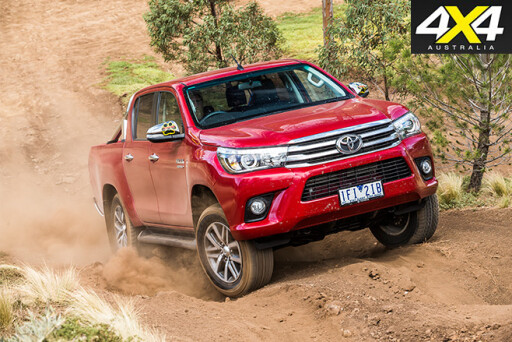 Sure, it will still be the biggest-seller, thanks to its legendary reputation and its thousands of fleet and business buyers, but Toyota has simply caught up with the competition, rather than surpassing it.
Sure, it will still be the biggest-seller, thanks to its legendary reputation and its thousands of fleet and business buyers, but Toyota has simply caught up with the competition, rather than surpassing it.
While other markets for the Hilux have got new tech including emergency autonomous braking and crawl control, Toyota Australia is holding back on those features for its buyers. But that won’t stop the Hilux selling its arse off and potentially being the best-selling car in the country in 2016.
SPECS
Engine: DOHC 16-valve 4-cyl turbodiesel
Capacity: 2.8-litre (2755cc)
Power: 130kW @ 3400rpm
Torque: 450Nm @ 1600-2400rpm
Gearbox: 6-speed auto
4X4 System: part-time dual-range
Crawl Ratio: 36.1:1
Construction: separate chassis
Front suspension: independent/coil springs
Rear suspension: live axle/leaf springs
Wheel/tyre spec: alloy/265/60R18
Kerb Mass: 2125kg
GVM: 3050kg
Payload: 925kg
Towing Capacity: 3200kg
Seating capacity: five
Fuel tank capacity: 80 litres
ADR fuel claim: 8.5L/100km
Price: $57,990 (inc auto and leather seats)
*Based on test fuel use, claimed fuel-tank capacity and a 50km ‘safety’ margin.
MORE 4X4 OF THE YEAR
 HOME: 4X4 OF THE YEAR 2016
HOME: 4X4 OF THE YEAR 2016
On the shortlist for 4X4OTY 2016 were the Hilux, Triton, Fortuner, Prado, Navara and Everest.
 THE FINALISTS
THE FINALISTS
The six best 4x4 vehicles of 2015 battling it out to be crowned 4x4 Of The Year 2016.
 THE RESULTS
THE RESULTS
Only one of the six best 4x4s from 2015 can be crowned 4x4 Of The Year 2016
 4X4 OF THE YEAR HOME
4X4 OF THE YEAR HOME
Finding Australia's Best 4x4s

COMMENTS